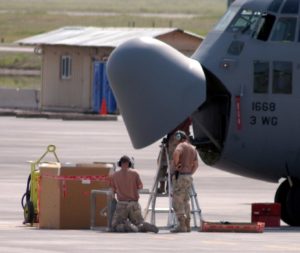
During Operation Enduring Freedom, C-130 Hercules maintenance airmen repair an avionics system at Karshi-Khanabad Air Base in Uzbekistan. Now, concerns have been raised about illnesses in servicemembers who served at the airbase. rmen and aircraft are deployed to the 416th Air Expeditionary Group here supporting Operation Enduring Freedom. Air Force photo by Tech. Sgt. Scott T. Sturkol
WASHINGTON — Veterans who have developed illnesses after serving in recent conflicts have enlisted powerful supporters in their fight to gain presumptive coverage for their conditions. Recent legislation would expand coverage to veterans who deployed to Uzbekistan as well as to those who served in a variety of other locations with open burn pits over the last 30 years.
In August, U.S. Sens. Richard Blumenthal (D-CT) and Tammy Baldwin (D-WI) introduced legislation that would extend “presumption of service connection” to include certain illnesses developed by former servicemembers who served at the Karshi-Khanabad Air Base (K2) in southeastern Uzbekistan. Senate Bill 4415 would require the VA to provide healthcare and disability benefits to these veterans without requiring them to prove the toxins on the base caused their illnesses.
The K2 Veterans Care Act of 2020 builds on legislation introduced in the House of Representatives earlier this year by Rep. Mark Green (R-TN) as H.R. 5957, the K2 Veterans Toxic Exposure Accountability Act of 2020. Green’s bill would require the DoD to study toxic exposures servicemembers may have encountered on the base. It would also mandate creation of a registry similar to the Burn Pit Registry.
The U.S. Army, Air Force and Marines used the former Soviet-era base from 2001 to 2005 to support activities in Afghanistan. Seven thousand servicemembers were stationed at K2 during Operation Enduring Freedom.
“This bill will bring life-saving relief to hundreds—and potentially thousands—of veterans who were exposed to extremely harmful toxins in the black goo and glowing ponds reported at K2,” Blumenthal said.
A DoD study in 2015 found a higher risk of malignant melanoma as well as neoplasms of the lymphatic and hematopoietic tissues in individuals who had been deployed to K2, also known as Camp Stronghold Freedom, than in other servicemembers. Non-Hodgkin lymphoma and leukemia were not found at higher rates. At the time, the limited number of cases precluded determination that serving at the base definitively caused the cancers.1
“The Pentagon has known for years that our U.S. troops were exposed to cancer-causing toxins while serving in Uzbekistan, and it’s simply wrong for the VA to deny them health care and disability benefits,” said Baldwin. “Our legislation does right by those who served at K2 and were exposed to health risks. We have a commitment to these troops, and we need to keep it.”
According to the Army Public Health Center, inspections in 2002 and 2004 found exposures of potential concern. Those included widespread jet fuel plumes from an underground fuel distribution system used by the Soviets, asbestos and low-level radioactive depleted uranium in the surface dirt from the destruction of Soviet missiles prior to U.S. use of the area, and high levels of particulate matter including dust as well as high noise levels.
At the time, the area with jet fuel plumes, asbestos and depleted uranium were covered with clean dirt to mitigate exposure. The affected areas had restricted access and required protective equipment for anyone disturbing the soil.
The Senate bill calls for coverage of diseases associated with toxins found at K2 and expansion of the VA’s Open Burn Pit Registry to include K2 veterans.
In April, the VA announced a new study of illnesses in veterans who served at K2. Results are not expected until early 2022.
Burn Pit Coverage
Similar legislation was introduced in both houses of Congress in September by Sen. Kirsten Gillibrand (D-NY) and Rep. Raul Ruiz, MD, (D-CA) to extend presumptive status to veterans who developed specific illnesses related to exposure to burn pits while deployed in any of 34 countries in Africa or Asia during the Global War on Terror or the Gulf War.
“Servicemembers are returning home from the battlefield only to become delayed casualties of war, dying years later from lung diseases, cancers, and respiratory illnesses caused by their exposure to toxic military burn pits,” Ruiz said. “The VA and DoD cannot continue to neglect this self-inflicted wound on our veterans.”
According to the Iraq and Afghanistan Veterans of America, 86% of its members have been exposed to burn pits or other toxins and a similar percentage have or could have symptoms from their exposure.
“The Presumptive Benefits for War Fighters Exposed to Burn Pits and Other Toxins Act will finally establish a presumptive service connection for veterans exposed to burn pits and other toxins and streamline the process for obtaining vital VA benefits,” added Gillibrand. The bill would categorize asthma diagnosed after service in one of the listed nations, any cancer, chronic bronchitis, chronic obstructive pulmonary disease, constrictive bronchiolitis or obliterative bronchiolitis, emphysema, granulomatous disease, interstitial lung disease, lymphoma, pleuritis, pulmonary fibrosis and sarcoidosis as presumptive conditions.
The burn pit bills received endorsement from a nonlegislator with keen awareness of the challenges involved in expanding healthcare coverage for presumed service-related conditions, former VA Secretary David Shulkin, MD: “Veterans exposed to burn pits are still waiting for help—we’ve had 30 years to study this—now it’s a moral obligation to act.”
- Sharkey JM, Abraham JH. Evaluation of Postdeployment Cancers Among Active Duty Military Personnel. US Army Med Dep J. Jul-Sep 2015;68-75.

